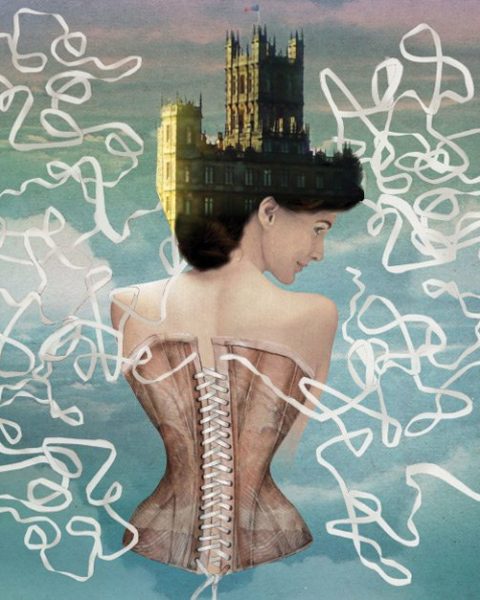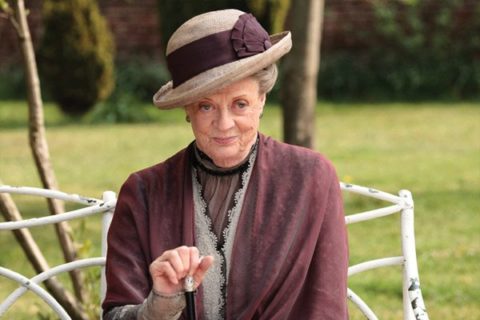Downton Fever: How a British period drama managed to get the reality-TV generation addicted


Browsing the newsstand at London’s Heathrow Airport last November, I found tabloids full of footballers’ wives, all orange of complexion and platform of shoe, and the glossier monthlies stocked with society girls. But whether their readers’ penchant was for players’ wives or the polo set, every magazine I read contained at least one story extolling the brilliance of Downton Abbey.
Meanwhile, in North America, despite winning six Emmys last September, Downton Abbey hadn’t yet broken into the mainstream. The ITV1 television series set in World War I–era England chronicles in equal measure the lives of the upper-class Crawley family and their servants. A quiet but respectable viewership had discovered the show in its first season on PBS’s Masterpiece Classic, but when season two began at the start of 2012, we fell into the grips of a collective Downton fever like a heartbroken fiancée succumbing to Spanish flu. This might be because Downton offers something for almost everyone. There is the wealth and glamour of the Crawley family, who dress every night for dinner as though they’re attending the Met Ball. Downstairs, the servants’ plays for household power mirror the tension of Glengarry Glen Ross, except here it’s “A-Always, B-Be, C-Conspiring.” And juxtaposed against the feeling that you’re watching a classic literary adaptation are elements that reflect a contemporary audience, from caught-in-the-act trysts to the characters learning how to use a telephone. Downton is no Greek drama, with the action happening offstage.
Of course, there is romance. The will-they-or-won’t-they relationships of two sets of lovers have kept viewers tuning in: more than five million watched the season two finale. In Canada, Downton is now enjoying a run on VisionTV on Wednesday evenings.
“There’s a cadre of people who are watching it because it’s an allowable soap,” says New Yorker TV critic Emily Nussbaum. “It’s dressed up in all sorts of fancy class indicators including, but not limited to, England, PBS and historical times, and rich people in large country houses.” And, as Nussbaum adds, it is very well made, costing roughly $1.6 million per episode to produce.
It’s also extremely fun to talk about. With season two came online recaps from New York magazine’s Vulture and Vanity Fair’s The Hollywood Blog (we at FASHION produced a wonderful one). Further signs of the show’s reach include character-inspired Twitter accounts and countless memes—all that’s missing is a Tumblr of Ryan Gosling Hey Girl–ing the women of Downton.

Just as the show popped up in those British tabloids, it has proven to have populist appeal in North America. In what sounds like a James Franco art project, US Weekly asked Big Ang from the reality show Mob Wives to recite the Dowager Countess’s best quips for an online video. Downton has famous fans, too. Some are predictable—Sarah Jessica Parker, Katy Perry—others are less so: comedian Patton Oswalt live-tweeted each airing.
Its fandom extends to the fashion flock. Creator Julian Fellowes could be accused of courting fashion editors from the first episode, in which Maggie Smith’s Dowager Countess proclaims: “No one wants to kiss a girl in black.” Should you want to take wardrobe inspiration from the show, Vogue has a shopping guide to help you “Dress the Part” of a Crawley sister. Designer Rebecca Minkoff complained of Downton withdrawal on Facebook. Recently, it seems every long, narrow skirt on the runway prompts a Downton Abbey reference from reviewers. The most theatrical embrace of the series has been by designer Ralph Lauren for his Fall 2012 presentation. As the TV show’s theme tune played, models walked the runway in smart tweeds and cloche hats, ready to quarrel with their fiancés at the hunt.
The show’s own wardrobe is deserving of attention. For her contribution to Downton, costume designer Susannah Buxton, whom Fellowes describes as a “sculptress in cloth,” recently won a Costume Designers Guild award. She and her team of seven make about 30 per cent of the program’s costumes; the rest are borrowed from prop houses as far away as the U.S. and Spain. “All of the dresses are so beautiful and the designers keep in mind [our] colouring,” says Laura Carmichael, who plays middle sister Edith. “So it’s really interesting to find what they think suits you.”
Buxton divulges that eldest sister Mary Crawley, a totem of heiress taste, has a wardrobe inspired by early Chanel. Matthew Crawley’s young fiancée from London, Lavinia Swire, greeted her future in-laws in a deco-embellished gown and Poiret-esque headband—a hint of 1920s trends to come. And who could forget the youngest Crawley, Sybil, in her harem dress and Turkish trousers?
But it’s not all velvet and beading. To preserve historical accuracy, all the female characters wear corsets, including the servants. “When you’re at hour 12 or 13, you can’t wait to rip it off,” admits Joanne Froggatt, who plays Anna, the head housemaid and lady’s maid to the Crawley sisters. She says there will still be corsets when season three picks up in the 1920s, but mercifully “the dress shape changes, and they are more comfortable because they have elastic in them.”
Corsets aren’t the only changes ahead for the ladies, who won’t want to give up the independence they found while working during the war. “For the older generation, with the relief of the war’s end comes this idea that they can go back to normal,” says Carmichael. “For the younger ones, particularly women who found a vocation, it will be very boring to go back to changing three, four times a day, and doing not much else.”
But aren’t those costume changes why we all tune in? Well, that and the dramatic twists and turns. (Disfigured amnesiac cousins! Dead visiting dignitaries! Revolution-minded chauffeurs!) Downton offers the satisfaction of guilty-pleasure TV without the tabloid aftertaste, and draws in viewers on a night once dominated by three other stinking-rich sisters: the Kardashians.

“If it’s Sunday, you know you’re watching E!” has been a cocky truism that felt like a taunt to anyone shamefacedly tuning in to the reality juggernaut Keeping Up with the Kardashians or one of its many sister shows. The Kardashians are certainly the product of a consumerist culture, along with The Real Housewives franchise, but now the excesses displayed by the subjects of these shows feel less like escapist fun and more like vulgar reminders of pre-recession overspending. While the Crawleys are certainly rich, they’re not flaunting it—Mary even repeats dresses at dinner.
Unlike most television programming, Downton Abbey doesn’t put youth on a pedestal. The show’s most quoted character is the Dowager Countess, the family’s 70-year-old matriarch. And it is she to whom all Crawleys go for wisdom (even at the risk of receiving one of her withering retorts). “All of the girls joke with their mother about her being American and not being able to understand,” says Carmichael. “I think there is this Englishness and tradition—and the way that things should be done—that comes down from the Dowager.”
Still, before you pat yourself on the back for choosing Team Crawley over Team Kardashian, consider that not everyone praises the series. Columbia University history professor Simon Schama condemned the program and its watchers on Newsweek’s The Daily Beast: “Downton serves up a steaming, silvered tureen of snobbery… the American public is desperate for anything to take its mind off the perplexities of the present.” He ended with: “Sorry, but history’s meant to be a bummer, not a stroll down memory lane.” It makes you wonder how his students make it through a semester.
A more common criticism is that season two took the drama a little too far. “People were outraged this season when there were things that were truly soap opera-y,” says Nussbaum. “But that’s what [the series] is. When people complain about it, they’re having an allergic reaction to the fact that the show they like is actually a melodrama.”
Froggatt astutely sums up the show’s winning recipe: “A lot of period drama is adapted from a novel, therefore you know the outcome, whereas this is original. Also, with the cross-section of the community within the house, there is a character for everybody to love—or love to hate.”
We’ll happily take the Dowager’s bons mots in gulps from that silvered tureen. And if the show dips into soap opera convention, so be it—at least it isn’t pretending that television is anything more than a lovely way to spend an evening. Perhaps it would be better to compare Downton Abbey to a woman rather than a history lesson, so, as the Dowager Countess says, it can be as contrary as it chooses.







